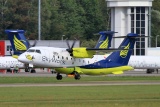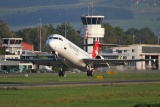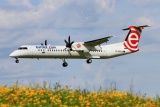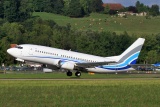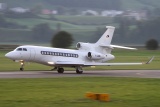By Tis Meyer and Ian Lienhard, aviation photographer based in Bern.

|
||||||
Introduction and Operations
Bern-Belp Airport lies about 5 kilometers southeast of the Swiss capital of Bern, outside the town limits of Belp - hence its second name. The airport features one concrete runway (14/32) of 1'730m/5'700ft as well as a grass runway and a glider strip. After a long history of many unsuccessful airline connections, its new home-carrier SkyWork is propelling the airfield up the statistical ranks: In 2011, a growth of 97% percent in passengers (170'000) and 106% in movements (7'200) has pushed it up to become the national number 4, behind the "big 3" of Zurich, Geneva and Basle.
Traffic
Generally speaking, Bern's traffic consists of about 75% scheduled flights and 25% charter flights. More than half of all flights at the airport are flown by SkyWork, who use their fleet of 5 Dornier 328 to connect Bern to over 20 central european destinations. While the planes usually head for important cities during the week, holiday flights to the Mediterranean are common on weekends. Zurich-based Helvetic Airways has entered the Bern market in 2011 (and partially upgraded to an Airbus A319 in 2013), operating holiday flights to Mediterranean destinations. Apart from those two home carriers, a small number of other airlines drop by for regular charter flights.There are too many changes to the fast growing flight network out of Bern to jot down all flights here; but if you plan a visit, have a look at the seasonal schedule on the airport's official website. Generally, in summer time, weekdays offer some more frequent SkyWork operations, whereas the weekends see a slight increase in airline variety.

Thanks to its proximity to the Swiss capital, which is also Switzerland's 4th biggest city, as well as to the nearby Alps, there is a fair amount of business aviation traffic at the airport. Several companies (like Nomad Aviation) have some of their aircraft based here, and there are usually between five and ten biz-jet movements a day. Additionally, Bern is also the base of the Transport Wing of the Swiss Confederation, transporting national members of the government as well as foreign delegations. As of 2011, the following aircraft are used:
- T-783: Falcon 50
- T-784: Cessna 560XL Citation Excel
- T-721: Beechcraft Super King Air
- T-729: Beechcraft 1900D
- T-351/352: Eurocopter EC-635
- T-311 - T-342: Several Aerospatiale Super Puma
In addition to those movements, Bern Airport is a popular General Aviation aerodrome, serves as the base of several Helicopter companies (REGA, Heliswiss, Mountainflyers), and is also used as a glider strip. There's always something buzzing in the skies of Bern!
Runway Operations

The one concrete runway is used by all commercial flights, and many of the small planes, too. Rwy 14 has an ILS system. Due to terrain restrictions in the south, Rwy 32 is usually approached using Rwy14's ILS and then breaking off for a tight, right hand visual circling. Note that taking off on Rwy 14 requires a backtrack of about half the runway's length.
Although the predominant winds in Switzerland are light westerlies, the main runway is Rwy 14, owing to its ILS system and the short taxi distance to the terminal after arrival. If the northwestern winds pick up significantly, Rwy 32 will be used. This seems to occur quite often on summer days, starting around noon, leading to Rwy 32 being in use in the afternoon.
Beware that pilots tend to ask for the most favourable runway for their flights. These wishes can be granted if a calm traffic situation allows. For example, many prefer Rwy 32 for takeoff, as it doesn't require a lengthy backtrack and offers shorter departure routes for west and southwest bound flights. However, this is of course not practicable if there's a flight already inbound for Rwy 14.
Getting there
There are two bus routes serving the airport. Route 334 ("Airport Bus"), running every half hour, connects the airport to the nearby railway station in the village of Belp, where local trains take you to Berne's main station. Another bus, numbered 160, follows the same route at different intervals, providing additional service. This bus continues on to other nearby villages after passing Belp train station, while the Airport Bus just runs between the station and the airport. There is no direct bus from the airport to Berne's Main Station anymore. From Berne's Main Station, it takes one hour to Basel and Zurich, and approximately two hours to Geneva, by intercity train.
More information as well as schedules can be found on the dedicated website of BernMobil.
Spotting Points
Click on the maps above and below for bigger resolutions
| Area around the terminal (Spots 1) | Area around the REGA Base (Spot 2) |
 |
 |
Spot 1: Terminal Area
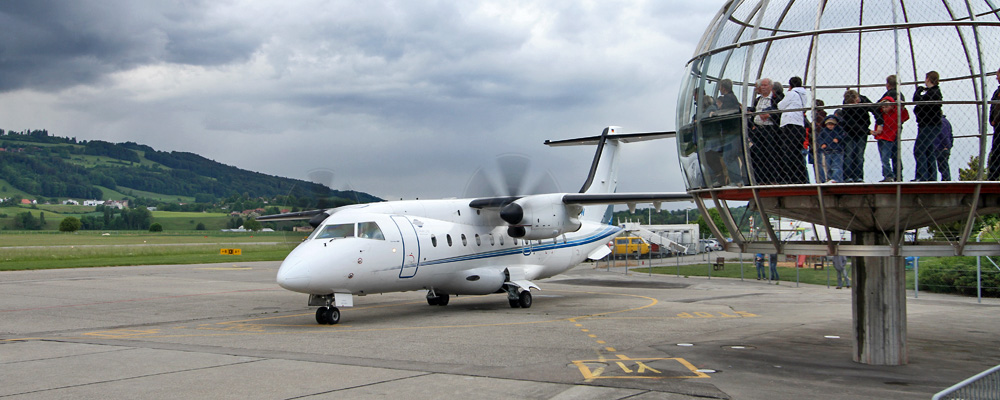
There are several viewing options close to the terminal. The most popular is the official "visitor's globe", positioned right in front of the terminal entrance, that offers views of the northern apron parts as well as the runway. This globe is covered in large parts by netting wire, restricting photography a little. The side facing the runway is made of plexiglass (see photo above). Views can also be had from a restaurant located in the old tower, from the "Propellerstübli" restaurant north of the terminal (Spot 1A) and the restaurant at the General Aviation sector south of the main terminal (Spot 1B).
| See "Getting There" section above. There are various parking options on offer, see the official airport website for more information. | |
| Restaurant, small shops and toilets available inside the terminal | |
| Starting from 15mm for wide-angle apron shots, acft on the runway need 150-250mm, and 400mm can be handy for action shots. | |
| All operations in either runway direction, apron traffic, parked acft. | |
| Until about 10-11AM in summer. | |
Spot 2: REGA Base parking
If runway 32 is in use during the morning hours this spot is the most recommended. Here you'll see the approaching aircrafts shortly before touchdown or when lining up. Aircrafts parked on the ramp in front of the governmental hangars always use intersection F in front of you, bigger aircrafts from the main ramp use the runway for backtracking. Next to you is the helipad of the swiss air ambulance REGA with a based Eurocopter EC145.
| Limited parking at the spot, more on the other side of the street. The local bus stops at the spot, too (Belp, Giessenbad). | |
| Restaurant and Toilets available inside the terminal | |
| About 100mm for an ATR42 on the runway, 60mm for a Citation C560 on the taxiway. | |
| Landings and takeoffs on runway 32, aircraft taxiing to the government area and the REGA Facility. | |
| Runway/Approach shots until about 10-11AM in winter | |
| Even if the fence isn't realy high and there are some stones to stand on, a small ladder would make it easier to spot here. |
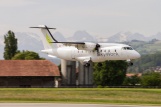 On finals for Rwy 32 |
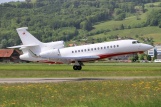 Touching down on Rwy 32 (78mm) |
 Rolling out on Rwy 32 (105mm) |
 Taxiing to the government apron (400mm) |
Spot 3: Heliswiss Base
This spot can be used for Rwy 32 operations in the afternoon, as well as for low climb-outs out of Rwy 14 and Helicopter operations. If the runway is too far away for your camera you can walk towards the runway using the pathway next to the farmer buildings in front of the Heliswiss base. On hot days heathaze makes it impossible to spot from this spot.
| Bus Nr. 333 from Belp's train station stops nearby; however, it only operates in the morning and evening peak hours of weekday. Otherwise' exit bus 160 at Muristrasse-Süd and walk down the Muristrasse for about 1km. | |
| There is a Landi next to the busstop Muristrasse-Süd with some refreshments, otherwise you have to go to the terminal. | |
| 250mm for a G-IV, around 50mm for helicopter movements around the Heliswiss facility | |
| Aircrafts approaching runway 32 and helicopter operations from the Heliswiss base. Aircrafts approaching the gliderstrip almost fly over your head. | |
| From 10-11AM until sunset | |
| Do not walk onto the Heliswiss tarmac without permission, even if there are no helicopteroperations! |
Spot 4: Gürbedamm/Rwy 14
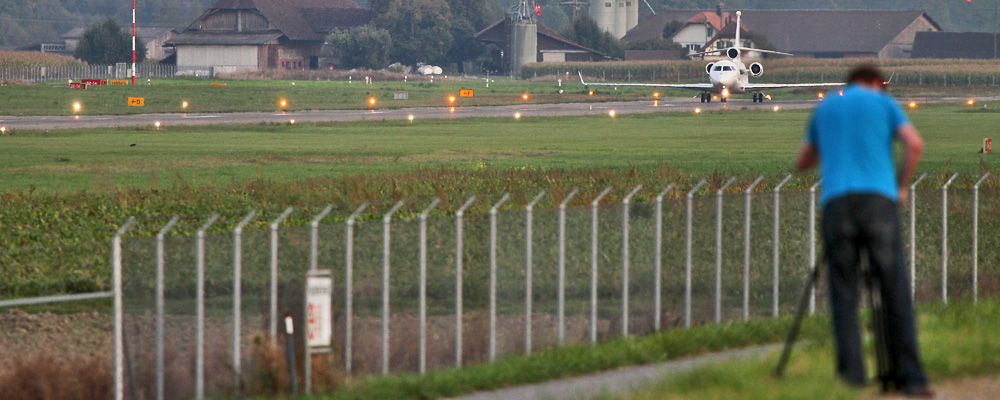
This is probably the most popular spot. A dam running along large parts of the runway, mostly in its northwestern sector, offers plenty of opportunities to take pictures. You can position yourself anywhere on the dam, depending on runway operations, expected traffic, and your personal taste. Since the dam is about 2 meters high, it lets you see over the fence without problems, and no ladder is required.
|
There are two ways to get here. If you haven't got a car, bringing a scooter/skateboard is a great idea
|
|
| No restaurant, shops or toilets near the spot. The closest options are at the terminal. | |
| 100-200mm for planes on the runway, up to 400mm for great action shots | |
| All operations on Rwy 14 (landings, backtracks). Faster arrivals into Rwy 32, climb outs from Rwy 32 (angle is good on most planes). | |
| From 11AM till sunset in summer. | |
| It's forbidden to drive along this side of the airport, so make sure to park your car on one of the marked car park areas on the map above and walk down. |
 Typical Rwy 14 approach shot |
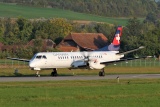 Backtracking Rwy 14 |
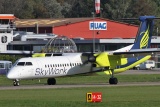 Rolling out on Rwy 32 |
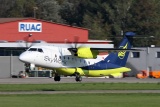 Early TO Rwy 32 (340mm) |
 Later TO Rwy 32 |
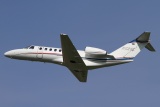 Climbout Rwy 32 |
Spot 5: Morning Arrival Spot
For Rwy 14 arrivals during the first half of the day, this spot in the vicinity of the terminal is handy.
| See Spot 1 and "Getting There" section above respectively. From the terminal, walk north along the fence, and then follow a turn in the road and the fence west all the way to the runway. | |
| Restaurant and Toilets available inside the terminal | |
| 100-150mm are enough to capture runway movements. | |
| All operations on Rwy 14, faster planes deccelerating after landing on Rwy 32. | |
| From sunrise till about 11AM | |
| A ladder is needed here since you are standing right next to the fence |
 Flaring just before touchdown on Rwy 14. |
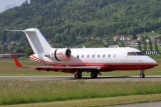 Deccelerating on Rwy 32. |
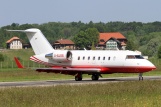 Turning around on Rwy 32 after landing. |
 Climbing out from Rwy 32. |
-
.

